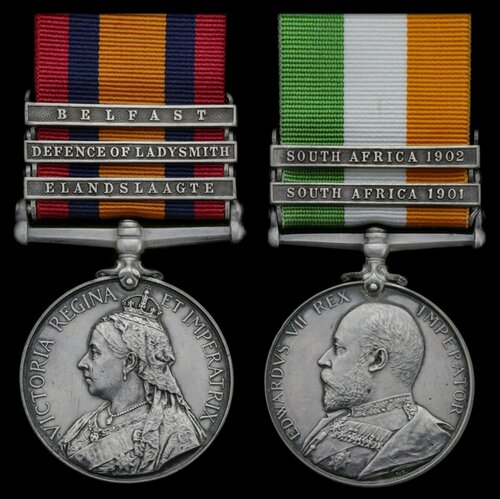
Auction: 21003 - Orders, Decorations and Medals
Lot: 175
(x) Pair: Corporal C. S. Philips, Devonshire Regiment
Queen's South Africa 1899-1902, 3 clasps, Elandslaagte, Defence of Ladysmith, Belfast (4483 Cpl. C. S. Philips, Devon: Regt.); King's South Africa 1901-02, 2 clasps, South Africa 1901, South Africa 1902 (4483 Corpl: E. S. Philips. Devon: Regiment), contact marks, slight edge bruising on first, post loose on second, very fine
Charles Samuel Philips was born in August 1877 at Paddington, London the son of William John Philips of North Kennington, London. He worked as a plumber's mate prior to enlisting with the Devonshire Regiment on 5 October 1895. Notably he was not the only member of his family to serve in the military, as his younger brother William John Philips joined the Royal Marines. Posted first to the East Indies, Philips served there from 28 February 1898 - 20 September 1899 when the Devonshire Regiment sailed for South Africa, arriving in 21 September. They joined Colonel Ian Hamilton's Brigade along with the 1st Battalion, Manchester Regiment and the 2nd Battalion, Gordon Highlander's.
Engaged first at Elandslaagte (21 October) they formed part of the reinforcements sent to join General French's small army advancing against the Boer defensive position on the hills above the Dundee railway. The plan was for the Manchester Regiment and Gordon Highlanders to push the enemy's centre and left up the hill and while the Devonshires drove into their right and the cavalry moved around their extreme left outflank them. This plan succeeded with the Gordons and Manchesters pushing the enemy back and the Devonshires attack hitting home while they were still reeling. Meanwhile the Imperial Light Horse cut across the hill and attacked their flank, losing their commander Colonel Chisholme. When the British had pushed past the Boer Guns to their camp a white flag was raised. However it seems that not all the Boers agreed with the surrender and those 'Bitterenders' opened fire again as the British showed themselves. At that moment Hamilton managed to rally his brigade into a bayonet charge, supported by the sudden appearance of the cavalry who charged the Boer flank, and broke the enemy's last resistance. Despite their victory, news of the Boer advances and the death of General Penn Symons at Talana Hill caused the army to withdraw to Ladysmith. They were engaged at Rietfontein and then again during the Siege of Ladysmith. Here the Devonshires excelled themselves in several engagements, most notably the Waggon Hill charge. Finally they shared in the action at Belfast, advancing alongside the 1st Royal Scots and the 1st Royal Irish.
Philips left South Africa with his regiment on 6 December 1902, returning to India on 19 January 1903. He did not see Britain again until 7 December by which time he had been promoted Corporal. Transferring the next day to the Army Reserve he was discharged completely at Exeter on 4 October 1911. Enlisting again for the Devonshire Regiment on 19 August 1916, he was posted to the Regimental Depot with the rank of Private - however he was promoted Corporal again the same day. Appointed Acting Sergeant on 27 November 1916, he later transferred to 3rd Labour Battalion on 25 April 1917 and was further transferred to the 'Z' Class Reserve on 3 January 1920; sold together with copied service documents and articles on the regiment's service.
Subject to 5% tax on Hammer Price in addition to 20% VAT on Buyer’s Premium.
Sold for
£1,100
Starting price
£320




